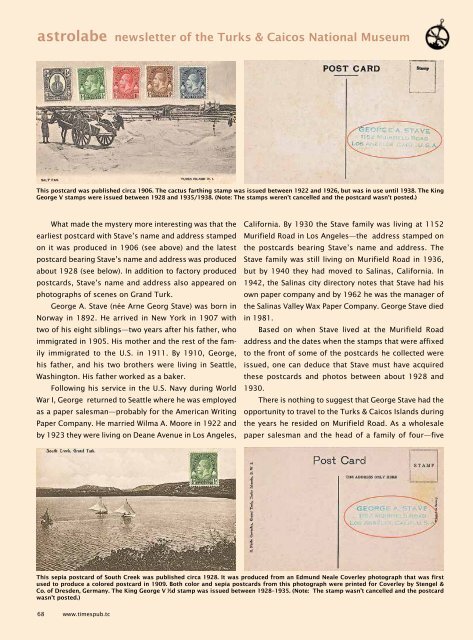Times of the Islands Spring 2023
Presents the "soul of the Turks & Caicos Islands" with in-depth features about local people, culture, history, environment, real estate, businesses, resorts, restaurants and activities.
Presents the "soul of the Turks & Caicos Islands" with in-depth features about local people, culture, history, environment, real estate, businesses, resorts, restaurants and activities.
Create successful ePaper yourself
Turn your PDF publications into a flip-book with our unique Google optimized e-Paper software.
astrolabe newsletter <strong>of</strong> <strong>the</strong> Turks & Caicos National Museum<br />
This postcard was published circa 1906. The cactus farthing stamp was issued between 1922 and 1926, but was in use until 1938. The King<br />
George V stamps were issued between 1928 and 1935/1938. (Note: The stamps weren’t cancelled and <strong>the</strong> postcard wasn’t posted.)<br />
What made <strong>the</strong> mystery more interesting was that <strong>the</strong><br />
earliest postcard with Stave’s name and address stamped<br />
on it was produced in 1906 (see above) and <strong>the</strong> latest<br />
postcard bearing Stave’s name and address was produced<br />
about 1928 (see below). In addition to factory produced<br />
postcards, Stave’s name and address also appeared on<br />
photographs <strong>of</strong> scenes on Grand Turk.<br />
George A. Stave (née Arne Georg Stave) was born in<br />
Norway in 1892. He arrived in New York in 1907 with<br />
two <strong>of</strong> his eight siblings—two years after his fa<strong>the</strong>r, who<br />
immigrated in 1905. His mo<strong>the</strong>r and <strong>the</strong> rest <strong>of</strong> <strong>the</strong> family<br />
immigrated to <strong>the</strong> U.S. in 1911. By 1910, George,<br />
his fa<strong>the</strong>r, and his two bro<strong>the</strong>rs were living in Seattle,<br />
Washington. His fa<strong>the</strong>r worked as a baker.<br />
Following his service in <strong>the</strong> U.S. Navy during World<br />
War I, George returned to Seattle where he was employed<br />
as a paper salesman—probably for <strong>the</strong> American Writing<br />
Paper Company. He married Wilma A. Moore in 1922 and<br />
by 1923 <strong>the</strong>y were living on Deane Avenue in Los Angeles,<br />
California. By 1930 <strong>the</strong> Stave family was living at 1152<br />
Murifield Road in Los Angeles—<strong>the</strong> address stamped on<br />
<strong>the</strong> postcards bearing Stave’s name and address. The<br />
Stave family was still living on Murifield Road in 1936,<br />
but by 1940 <strong>the</strong>y had moved to Salinas, California. In<br />
1942, <strong>the</strong> Salinas city directory notes that Stave had his<br />
own paper company and by 1962 he was <strong>the</strong> manager <strong>of</strong><br />
<strong>the</strong> Salinas Valley Wax Paper Company. George Stave died<br />
in 1981.<br />
Based on when Stave lived at <strong>the</strong> Murifield Road<br />
address and <strong>the</strong> dates when <strong>the</strong> stamps that were affixed<br />
to <strong>the</strong> front <strong>of</strong> some <strong>of</strong> <strong>the</strong> postcards he collected were<br />
issued, one can deduce that Stave must have acquired<br />
<strong>the</strong>se postcards and photos between about 1928 and<br />
1930.<br />
There is nothing to suggest that George Stave had <strong>the</strong><br />
opportunity to travel to <strong>the</strong> Turks & Caicos <strong>Islands</strong> during<br />
<strong>the</strong> years he resided on Murifield Road. As a wholesale<br />
paper salesman and <strong>the</strong> head <strong>of</strong> a family <strong>of</strong> four—five<br />
This sepia postcard <strong>of</strong> South Creek was published circa 1928. It was produced from an Edmund Neale Coverley photograph that was first<br />
used to produce a colored postcard in 1909. Both color and sepia postcards from this photograph were printed for Coverley by Stengel &<br />
Co. <strong>of</strong> Dresden, Germany. The King George V ½d stamp was issued between 1928–1935. (Note: The stamp wasn’t cancelled and <strong>the</strong> postcard<br />
wasn’t posted.)<br />
68 www.timespub.tc
















